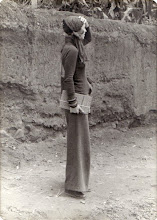Danto - The artistic terrain is constituted in virtue of artistic theories.
Bourdieu - The field of cultural production is a system of objective relations between these agents or institutions, the site of struggle for monopoly for the power to consecrate; it is in this field that the value of works of art and belief in that value are continuously generated.
How the art world creates, destroys or overlooks a persona, a practice or an artist, is both the manifestation and propagation of the very definition of a cultural producer as fitting its institutional layout. When going back to rescue a 'cultural producer' from a historical black hole, his matter is re-created, or created, according to the past and current theories of art, of artistic production, of historical and theoretical sanctification. He who previously did not satisfy the cultural capital, the outlines of sanctified practices, the self-creation along party lines, can be resurrected as an icon of that very world whose rules which he failed or avoided, skirted or denied. Edie Sedgwick was socially sucked in, becoming a subject rather than an author, whose social position was denied artistic intentionality (though her life can be artistically revisited - Factory Girl. Henry Darger's isolation from the art world centers denies him artist-hood, while the relocation of his work to an art world setting elevates it to the rank of art (Darger's illustrations). Ray Johnson was a self-creating, almost mythical character who never allowed his work to be publicly exhibited via traditional channels, and today the manifestations of his social position are celebrated as artistic productions. This social self-consciousness as a part of the art world and yet materially apart from it in his work shed interesting light on social positionality in the art world as seen by Bourdieu and the institutional conceptions of authorship and subjecthood.
Chuck Close, from How To Draw a Bunny - available to watch instantly on Netflix - anyone can borrow my copy as well.
When Chuck Close curated Artist's Choice: Head-On in 1991 at the MOMA, he both defined his socio-artistic position as a contemporary artist and insider, and introduced New York's "most famous unknown artist" to the same white cube as portraits by Van Gogh, and of Marcel Duchamp. As he brought in Ray Johnson's bunny portraits of contemporary artists and art world figures in through the back door of the mail room, rather than the front door of acquisitions, it became salient that Johnson was the ultimate "arch-insider" (Danto ): the place created for him by the art world allowed him tobe a "living sculpture" (James Rosenquist), able to reference the art world through his personal impact on its players, and the snowball effects of his correspondences, without explicitly making art. Although he called his collages, "Chop art, not Pop art", Johnson usually let others try to fit him into their conception of the art world.
The art world exposé, the first-person account, even the theorizing of its observers, are social documentary, not only framed by their insertion into the historical, cinematic, theoretical library, the repository and reference guide of common man and his progeny, but also recorded while being simultaneously self-edited, selected, and historicized. The players depend on each other for their own reflections, to understand their social position, and to recognize their presence as artists above the presence of their art - or even to know what to create and what they've created in the first place. The art world is both self-destructive in its rejection of permanence and totally subjugated to its own historical precedence for legitimation and creative impetus. By rejecting what it feared most, AbEx helped define Pop art, thus bringing it into existence, not as non-art but as non-normative art, at fault with the dominant discourse. Just Clement Greenberg's decision that Pop art was worthy of rejection seems to have begun the destruction of the very discourse he created and wanted to preserve. Ever since art for art's sake, and the incorporation of self-criticism into the creative process, every time an artistic subculture or fringe is consciously rejected by the dominant discourse, it is historicized, incorporated into the fold, and thus expands the theory it may itself be contesting.
In the chillingly close-minded art world portrayed by Who the Fuck is Jackson Pollock, provenance trumps aesthetic experience because the value of Pollock's authorship has been pre-defined. The intruding painting's presence must fit into the historical foundation of the current art world, which its truck-driving, blasphemous backer does not. Ultimately, its value must be backed by money, in lieu of correct sociocultural capital. Like Danto said, "what is art today could not have been art 50 years ago," and the inseparability of art from author, and author from institutionally defined existence, makes the "uncovered" painting a gaping hole in the art world's comprehensive embodiment of all that it sees as art.


Aucun commentaire:
Enregistrer un commentaire